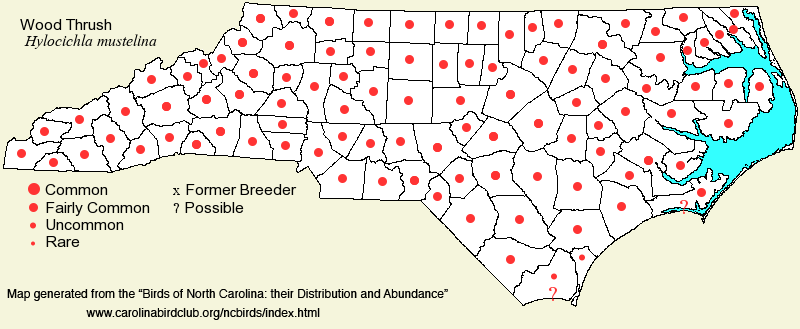 |  |
|
Wood Thrush - Hylocichla mustelina TURDIDAE Members: | Search Common: Search Scientific: |
|
|
|||||||
| General Comments | The Wood Thrush is one of the characteristic breeding birds of the Eastern deciduous forest. Its range does not extend from coast to coast like its near relatives, the Catharus thrushes, nor is it found in coniferous woods. It nests in all 100 counties in the state; sadly, however, it has been on a moderate decline across its range in the past one or two decades. Formerly considered "common" across the state, and one of the several most numerous breeders in hardwood forests, including wooded residential areas, it is now best called only "fairly common". It has disappeared from many wooded neighborhoods where present only five to ten years ago. Reasons for the decline have been suggested to be cowbird parasitism, loss of small snails (food) due to acid deposition, loss of wintering habitat, and maybe other factors. Loss of breeding habitat cannot be blamed, as other formerly common associates of hardwood forests -- Red-eyed Vireo, Acadian Flycatcher, and Ovenbird, among a few other highly migratory species -- are still common. Breeding habitat in the state must contain a moderate scatter of saplings or small trees, shrubs, and a rich herb layer; the canopy is typically hardwoods, but it can also be a mix of pines and hardwoods and occasionally just pines and other conifers (such as a mature pine stand but with moderate understory growth of hardwood trees). It favors moist sites to dry ones, and it can even nest in residential areas as long as there are woodlots nearby. There are a handful of winter reports, some by experienced observers, though some reports are open to question, as the species is typically gone from the state by mid-October. | ||||||
| Breeding Status | Breeder | ||||||
| NC BRC List | Definitive | ||||||
| State Status | |||||||
| U.S. Status | |||||||
| State Rank | S4B | ||||||
| Global Rank | G4 | ||||||
| Coastal Plain | Summer resident, strongly declining. Formerly (prior to perhaps 2000) common across most of the province, but absent on many or most coastal islands, and not common close to the coast, such as on the Pamlimarle Peninsula. Now uncommon to fairly common across that same range, and uncommon toward the coast. Mainly mid-Apr to early Oct. One winter report: 1, Wilmington, 30 Dec 1995. Peak counts: | ||||||
| Piedmont | Summer resident, strongly declining. Formerly common, to even very common in some areas; now only uncommon to fairly common, across the province. Mainly mid-Apr to early Oct. Four winter reports, from 9-30 Dec, in Halifax, Durham, Guilford, and Surry. Peak counts: | ||||||
| Mountains | Summer resident, declining. Formerly common up to about 4,500 feet, and scarce to 5,000 feet; now only fairly common at best to 4,500 feet, and quite rare to 5,000 feet. One was photographed on 7 Nov 2024 near Brevard (Transylvania) for a quite late date. Mainly mid-Apr to early Oct. Peak counts: | ||||||
| Finding Tips |
Before 2000, this was a "gimme", but now it can be missed in a morning of birding even in prime habitat. Even so, a half-day spent in most state parks in the Piedmont, for example, should turn up one to several birds. *** | ||||||
| Attribution | LeGrand[2025-02-04], LeGrand[2023-03-28], LeGrand[2015-01-29] | ||||||
| NC Map Map depicts all counties with a report (transient or resident) for the species. | Click on county for list of all known species. |
| NC Breeding Season Map Map depicts assumed breeding season abundance for the species. |  |